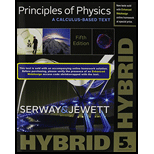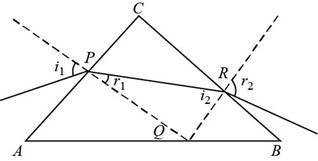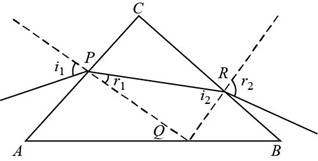
A ray of light strikes the midpoint of one face of an equiangular (60°−60°−60°) glass prism (n = 1.5) at an angle of incidence of 30°. (a) Trace the path of the light ray through the glass and find the angles of incidence and refraction at each surface. (b) If a small fraction of light is also reflected at each surface, what are the angles of reflection at the surfaces?
(a)
The trace of path of the light ray through the glass and the angles of incidence and refraction at each surface.
Answer to Problem 25P
The angles of incidence and refraction at surface

Explanation of Solution
Introduction:
When a ray incidents on the glass then the rays get refracted through angle of refraction
Given info: The angle of incidence at surface
The path of the light ray through the glass is shown below,

Figure (1)
Write the Snell’s law, for surface
Here,
Rearrange the above expression for
Substitute
Thus the incidence angle at surface
From the figure, the corresponding angles are equal.
Substitute
From the figure, the alternate angles are equal.
Substitute
From the figure
Substitute
Thus the angle of incidence at surface
Write the Snell’s law, for surface
Here,
Rearrange the above expression for
Substitute
Thus the angle of refraction at surface
Conclusion:
Therefore, the angles of incidence and refraction at surface
(b)
The angles of reflection at each surface.
Answer to Problem 25P
The angle of reflection at surface
Explanation of Solution
Given info: The angle of incidence at surface
From the angle of reflection at surface
Here,
Rearrange the above expression for
Substitute
Thus the angle of reflection at surface
From the angle of reflection at surface
Here,
Rearrange the above expression for
Substitute
Thus the angle of reflection at surface
Conclusion:
Therefore, the angle of reflection at surface
Want to see more full solutions like this?
Chapter 25 Solutions
Principles of Physics: A Calculus-Based Text, Hybrid (with Enhanced WebAssign Printed Access Card)
- Light traveling in a medium of index of refraction n1 is incident on another medium having an index of refraction n2. Under which of the following conditions can total internal reflection occur at the interface of the two media? (a) The indices of refraction have the relation n2 n1. (b) The indices of refraction have the relation n1 n2. (c) Light travels slower in the second medium than in the first. (d) The angle of incidence is less than the critical angle. (e) The angle of incidence must equal the angle of refraction.arrow_forwardThe index of refraction for water is about 43. What happens as a beam of light travels from air into water? (a) Its speed increases to 43c, and its frequency decreases. (b) Its speed decreases to 34c, and its wavelength decreases by a factor of 34. (c) Its speed decreases to 34c, and its wavelength increases by a factor of 43. (d) Its speed and frequency remain the same. (e) Its speed decreases to 34c, and its frequency increases.arrow_forwardWhat happens to a light wave when it travels from air into glass? (a) Its speed remains the same. (b) Its speed increases. (c) Its wavelength increases. (d) Its wavelength remains the same. (e) Its frequency remains the same.arrow_forward
- A ray of light strikes a flat, 2.00-cm-thick block of glass (n = 1.50) at ail angle of 30.0 with respect to the normal (Fig. P22.18). (a) Find the angle of refraction at the lop surface. (b) Find the angle of incidence at the bottom surface and the refracted angle. (c) Find the lateral distance d by which the light beam is shifted. (d) Calculate the speed of light in the glass and (e) the time required for the light to pass through the glass block. (f) Is the travel time through the block affected by the angle of incidence? Explain.arrow_forwardLight passes from a material with index of refraction 1.3 into one with index of refraction 1.2. Compared with the incident ray, what happens to the refracted ray? (a) It bends toward the normal. (b) It is undeflected. (c) It bends away from the normal.arrow_forwardA light ray travels from air (n=1.00) into a crown glass (n=1.52) with an angle of incidence of 49 degrees. The light ray continues to travel through the crown glass material into the diamond (n=2.42). At what angle does the light ray make with the normal line as it enters the diamond?arrow_forward
- Light, when incident on a given surface, presents a reflected and a refracted component. When the reflected beam is perpendicular to the refracted beam, the angle of incidence θᵢ is called Brewster's angle. If a beam of light is initially in air with index of refraction n₁ = 1 and is incident on a glass surface (index of refraction n₂ = 1.5), Brewster's angle is: a)82.9° b)36.3° c)75.4° d)62.9° e)56.3° f)45.7°arrow_forwardA ray of light passes from medium A to medium B. If the angle of incidence is 30° and the angle of refraction is 38°, which of the following statements is TRUE? A. The index of refraction of A is greater than the index of refraction of B. B. The index of refraction of A is lower than the index of refraction of B. C. A and B have equal indices of refraction. D. It cannot be determined unless at least one index of refraction was given. E. It cannot be determined unless the types of material of the two media were given.arrow_forwardA ray of light strikes the midpoint of one face of an equiangular (60°–60°–60°) glass prism (n = 1.5) at an angle of incidence of 31.4°. (a) Trace the path of the light ray through the glass, and find the angles of incidence and refraction at each surface.First surface: ?incidence = ° ?refraction = ° Second surface: ?incidence = ° ?refraction = ° (b) If a small fraction of light is also reflected at each surface, find the angles of reflection at the surfaces. ?reflection = ° (first surface) ?reflection = ° (second surface)arrow_forward
- A fiber optic line is composed of a core with an index of refraction of 1.47 and cladding with an index of 1.36. Which one of the relations best describes angles of incidence q that will result in total internal reflection within the fiber optic line?arrow_forwardAt what angle of incidence should a light beam strike a glass slab of refractive index ✓3, such that the reflected and the refracted rays are perpendicular to each other?arrow_forwardA light ray travels from air (n=1.00) into a crown glass (n=1.52) with an angle of incidence of 49 degrees. The light ray continues to travel through the crown glass material into the diamond (n=2.42). At what angle does the light ray make with the normal line as it enters the diamond? 12 deg 48 deg 30 deg 18 degarrow_forward
 Principles of Physics: A Calculus-Based TextPhysicsISBN:9781133104261Author:Raymond A. Serway, John W. JewettPublisher:Cengage Learning
Principles of Physics: A Calculus-Based TextPhysicsISBN:9781133104261Author:Raymond A. Serway, John W. JewettPublisher:Cengage Learning College PhysicsPhysicsISBN:9781305952300Author:Raymond A. Serway, Chris VuillePublisher:Cengage Learning
College PhysicsPhysicsISBN:9781305952300Author:Raymond A. Serway, Chris VuillePublisher:Cengage Learning Physics for Scientists and Engineers: Foundations...PhysicsISBN:9781133939146Author:Katz, Debora M.Publisher:Cengage Learning
Physics for Scientists and Engineers: Foundations...PhysicsISBN:9781133939146Author:Katz, Debora M.Publisher:Cengage Learning An Introduction to Physical SciencePhysicsISBN:9781305079137Author:James Shipman, Jerry D. Wilson, Charles A. Higgins, Omar TorresPublisher:Cengage Learning
An Introduction to Physical SciencePhysicsISBN:9781305079137Author:James Shipman, Jerry D. Wilson, Charles A. Higgins, Omar TorresPublisher:Cengage Learning



